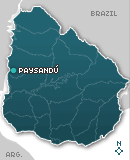Tours and Activities:
Along the Corridors of History
Marcelo Sola Marcelo SolaThe historical roots of the Department of Paysandú and its current prominence can be found when walking along the corridors of the Municipal Historical Museum.

In our tour around the city, we headed for the Municipal Historical Museum to get to know, apart from books, the history of Paysandú in a more interesting way.
The building we visited was opened on November 1, 1890 as the headquarters of the Escuela Asilo Maternal (Child Care Home and –School) in Paysandú. It was the first school in the country belonging to the Misión de las Hermanas del Huerto (Mission of the Orchard’s Sisters). It was then used as a place to display art and eventually some municipal workshops took place there along with singing lessons. The technical school also used its facilities for educational purposes.
The local administration refurbished it and called it "House of the Spirit of Paysandú” and it became the venue of several commissions related to the department since August 1984. On October 4, 1988, the Executive Power declared it a Historical Monument and on October 26, 1989 the Municipal Historical Museum was relocated there.

Inside the building, there are valuable items related to the history of the city. The guide of the museum told us about the most important events that took place in the region, from the time it was inhabited by the Charrúa natives until today.
“There are records from the early days containing the name Paso del Sandú and island of Ypausandó -today island of Charity- as a place where the cattle passed through. From a place where the cattle passed through at the end of the 1700 it changed into an active port, where they produced salt to make tasajo (dry salted meat) and to stock hide", said the guide.
Paysandú was one of the cities that suffered the passing of foreign and domestic troops during the fights for the independence of the country. “In 1811 Paysandú was defeated after a long fight against the Lusitanian troops. It was the first defense of Paysandú. Many years of warfare were ahead and then in 1846 the second defense took place against the Rivera troops in which they would be defeated again. The third defense of the city took place during the revolution led by General Venancio Flores and after 33 days of seige, on January 2, 1865, the city was defeated yet again”, said the local guide while she showed us weapons, symbols and models of the city at that time.

The museum has two large rooms and an outdoor garden. In the first room, we could travel back in time to the colonization period in Uruguay where the department went through independence battles. In the second room there was current information about Paysandú.
All along the display, we found sculptures by national artists, a picture collection and an important weapon and coin collection from the 19th century. Also, we were able to see the furniture, musical instruments, clocks and beautiful murals of the time portraying the most remarkable cultural events in the city.
The remains of the pedestal and a Carrara marble step where the Statue of Liberty was erected stand out in the garden. The statue was formerly located in Constitución Square, but in 1864 it was destroyed.

After a detailed-oriented observation of the items on display at the museum, we ended our tour. The sun began to fade in the horizon indicating the end of the day. The next morning we would get to see more of the city but we had already learned about the most important events in its history.
© 2007-2024 Total or partial reproduction forbidden. Derechos de Autor 675244 Ley 11723


 See also:
See also: 



